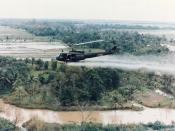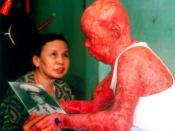Agent Orange
Just saying the name Agent Orange gets the attention of every Vietnam veteran, and I dare say most of the Australian and American public, not to mention the Vietnamese. It has been argued about, written about, researched and debated, published in magazines and newspapers, talked about on radio and television. It was the subject of documentaries, legal battles, and in Australia a Royal Commission that lasted some two years and cost 3.8 million dollars. Agent Orange was the code name for a herbicide developed for the military, primarily for use in tropical climates. Although the genesis of the product goes back to the 1940's, serious testing for military applications did not begin until the early 1960's. The purpose of the product was to deny an enemy cover and concealment in dense terrain by defoliating trees and shrubbery where the enemy could hide. The product "Agent Orange" (a code name for the orange band that was used to mark the drums it was stored in) was principally effective against broad-leaf foliage, such as the dense jungle-like terrain found in Southeast Asia.
The product was tested in Vietnam in the early 1960's, and was brought into ever widening use during the height of the war in 1967-68, though it's use was diminished and eventually discontinued in 1971. Agent Orange was a 50-50 mix of two chemicals, known conventionally as 2,4,D and 2,4,5,T. the combined product was mixed with kerosene or diesel fuel and dispersed by aircraft, vehicle, and hand spraying. An estimated 19 million gallons of Agent Orange were used in South Vietnam during the war. The earliest health concerns about Agent Orange were about the product's contamination with TCDD, or dioxin. TCDD is one of a family of dioxins, some found in nature, and are cousins...



Ok
I thought that while the information contained in the essay was good, it was badly structured, and would have been better divided up into sections or paragraphs.
5 out of 5 people found this comment useful.